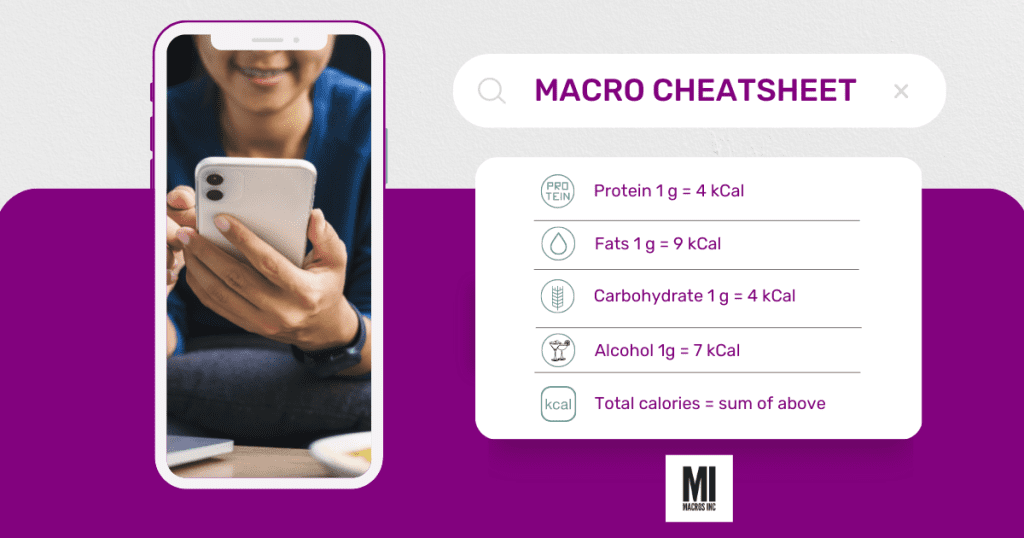“How to Lose Weight” is one of the most popular search terms put into the Google machine each year. In fact, last year, it ranked as the 52nd highest ranking search term in the United States.
Despite it being one of the most popular search terms, most people don’t really understand what actually drives weight loss and how the nutrients in their food affect, or do not affect, their ability to lose weight.
Specifically, most people don’t understand how the calorie providing nutrients, known as Macronutrients (“Macros”), play a role in their diet and their weight loss
This article will cover exactly how weight loss occurs and what role, if any, macros play in weight loss. It will also tell you how to calculate the macros you should follow to help you reach your goals this year.
Factors That Affect Weight Loss
Before we dive into what the best macros for weight loss are, we need to take a quick detour and discuss how weight loss occurs and the factors that affect weight loss.
Weight loss that is independent of changes in water weight, can only occur through one mechanism: an imbalance of energy where a person expends more energy than they are consuming better known as calories in – calories out.
Calories in Calories out (CICO)
So what does CICO mean? It means that there are actually only two major things that control weight loss:
- The energy going into your body.
- The energy your body utilizes.
So all you have to do to lose weight is to make sure your body is using more energy over a period of time than you are consuming.
The energy going in part of the equation is relatively straightforward; it is just the amount of calories that you consume from your food (more on that below).
The calories-out part of the equation gets slightly more complicated, but in reality we can break it into two major pieces: resting energy expenditure and non-resting energy expenditure.
Resting energy expenditure (REE)
REE is the energy it takes your body to function without doing any additional physical activity. This is the energy you spend to pump blood, think, breathe, create chemicals in your body, etc.
Resting energy expenditure varies substantially person to person and is mostly dictated by height and weight. Generally, the taller you are and the more you weigh, the greater your metabolic rate is.
Non-resting energy expenditure (NREE)
NREE is the energy it takes your body to do everything else, which fundamentally boils down to three main things:
1) digesting food, which we call the thermic effect of food (TEF),
2) physical activity of daily living that is non-exercise activity, which we call non-exercise activity thermogenesis (NEAT), and
3) physical activity that is structured exercise, which is called exercise activity thermogenesis (EAT).
So… to sum this part up, the things that drive weight loss are the foods you consume and the amount of energy you expend!
Should I Focus On Macros or Calories For Weight Loss?
Now the main question here is, if calories are the main thing to consider for weight loss, why are macros important for weight loss?
Well, I think the first place to start is to understand that the term “macros” and even the concept of “macros” is just categorizing the types of nutrients in your food that actually provide calories.
Side Note: “macros” is short of “macronutrients” and the other class of nutrients, micronutrients, do not provide calories to the body.
Realistically, the foods you consume contain one or more of the following types of calorie providing nutrients:
Each of these categories of nutrients affects calories in a few different ways, both directly and indirectly.
First, for the “directly”. Each type of macronutrient has a specific number of calories it provides the body per gram of the nutrient. Here is a quick table showing the breakdown of each.

In summary, 1g of protein or carbohydrates equals 4 calories, 1g of fat is 9 calories and 1g of alcohol equals 7 calories.
Why All Calories Are The Same… But Not
Now for the “indirectly” aspect. We have all heard the term, “a calorie is a calorie” which is 100% true… but there is some nuance required there. Here is that nuance
A calorie is a calorie. It is a unit of energy.
A calorie from one source of food is in fact the same as a calorie from another source of food.
A calorie from a twinkie is the same as a calorie from a piece of chicken.
But that doesn’t mean that consuming each of those calories and the food they are bound up in have the same effect on your body.
Eating a calorie from a twinkie will be less satiating than eating a calorie from a piece of chicken. Mostly because the chicken has more protein, which helps with hunger and keeps you full longer than a twinkie.
Also, eating a calorie from a twinkie will be less helpful for building muscle mass than eating a calorie from a piece of chicken.
Eating a calorie from a twinkie will be more enjoyable than eating a calorie from a piece of chicken and you will likely want another twinkie more than you will want another piece of chicken.
To summarize here, the macros you consume affect the calories you consume based on the calorie density per gram you consume (e.g. you eat 100 grams of protein you consume 400 calories, but if you consume 100 grams of fat you consume 900 calories). They also can affect the total calories you consume a day based on how certain macronutrients affect hunger, fullness, etc.
What Is The Best Macro Ratio For Weight Loss?
Now for the million dollar question… Is there the ideal blend of macros in a diet?
The answer here is both YES and NO. Let me explain in more detail.
Individual macronutrients can have effects that would suggest they may be more favorable to a lower calorie intake and a higher calorie expenditure.
The Benefits of Protein
For example, we know that protein as a macronutrient provides the most amount of “satiety” per gram and it has the highest thermic effect of food, meaning that the body uses more energy to process it than other macronutrients.
So together, it would seem that high protein intakes protein would appear to be more favorable for weight loss.
And, this actually appears to be true across almost all of nutrition science literature. However, you can’t really just eat an all protein diet and live a normal, athletic life for long periods of time, so there is a bit of a cap of how much of your diet should be protein (more on that in the next section).
Carbohydrates and Fats
Now for fats and carbohydrates. This is where a lot of the debate in the nutrition world is, and I think we can break this down pretty quickly and easily.
If we hold them in isolation, fats as a nutrient appear to be slightly worse for weight loss due to the fact that they have more calories per gram, they are less satiating than carbohydrates, and they actually get stored much more easily as body fat when eaten in a surplus than carbohydrates.
However… in the real world people don’t eat diets of just one macronutrient, they eat diets of mixed macronutrients and so it is really important to understand how diets of different compositions of different amounts of macronutrients affect weight loss.
It turns out that diets with mixed macronutrients all have VERY similar effects on weight loss. Once protein is accounted for, the exact mix of carbohydrates versus fat does not seem to make a meaningful difference for weight loss.
How Different Diets Affect Weight Loss
Studies that have compared diets that have similar calorie intakes but different macronutrients, show similar weight loss when the same calories are consumed.
Even where there are major differences in carbohydrates, fats, or proteins in the diet, weight loss and maintenance of weight loss is virtually identical. The main thing that explains the weight loss is the degree of calorie deficit.
This same phenomena is observed when we look at diets that are different in the types of foods and the overall philosophy of the diet.
For example, when comparing weight loss between vegan diets, high-fat diets, or “point” counting diets, when adherence and calories are accounted for, weight loss is identical between all of them.
This should make it pretty clear that the exact macro ratio you choose won’t have a major effect on your weight loss, but rather calories will. So, how do you decide what macros you should follow?
Great question, let’s tackle that next.
What Should My Macros Be For Weight Loss?
The easiest way to calculate your macros is to run a macro calculator but we’ll run you through the science behind how your unique macros are determined here.
- How tall are you and how much do you weigh?
- What is your goal (weight loss, gain, maintenance, etc.)?
- How physically active is your job?
- How much do you exercise, and how intense is it?
The first question tells you the starting point for where we should think about your total calorie needs as MOST of the total calorie needs are determined by your body mass (remember how BMR makes up most of your energy expenditure).
The second question tells us whether we need to make sure your energy (calorie) needs are below or above your energy expenditure.
The third tells us how much NEAT you probably expend in a day.
The last tells us how much protein and carbohydrates you likely need. Generally speaking people who engage in more resistance training need slightly higher protein than people who do not.
Also, people who engage in more exercise volume (total amount) and intensity need more carbohydrates than someone who does not.
To keep the math really simple here, most people can use the following approach to determine their macros:
- Set protein between 0.7 and 1.0 grams per pound of body weight. With the exception being, if you have more than ~50 pounds to lose, set it at ~0.8 grams of goal body weight.
- Set carbohydrates at ~1 gram per pound of body weight if minimally active or 2 grams per pound of body weight if very active. With the exception being, if you have more than ~50 pounds to lose, set it at closer to 0.7-1.0 grams per pound of body weight.
- Figure out your total calorie needs and fill the rest of the calories in with fats.
Run our calculator? Have your individual macros checked personally by one of our coaches for free in our community!



